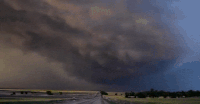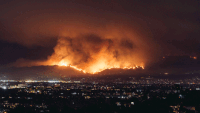If you have been thinking our weather has been extreme the last few years, you are correct. A study was released recently by the European Academies’ Science Advisory Council, which is made up of the 27 national science academies in the European Union, Norway, and Switzerland. The study found that hydrological events, such as floods and landslides, have quadrupled worldwide since 1980 and have doubled since 2004. It also found that climatological events, such as extreme temperatures, droughts, and forest fires, have more than doubled since 1980. And it found that meteorological events, such as storms, have doubled since 1980, the council said in a statement. Professor Michael Norton, EASAC’s environment program director, said in the statement that the “latest data supports our original conclusions: there has been and continues to be a significant increase in the frequency of extreme weather events.

The study said there had been a “significant uptick in floods and other hydrological events compared with even five years ago,” the council said. The extreme weather events carry substantial economic costs, the council said. It found that losses from thunderstorms in North America had doubled from under $10 billion in 1980 to nearly $20 billion in 2015. The study also reviewed evidence on what the council said were “key drivers of extreme events.

It said that debate remained ongoing on whether the Gulf Stream will decline or just switch off because of climate change. A shutdown of the Gulf Stream, which brings warmer ocean water from the Gulf of Mexico to warm Europe, could have major implications for the continent’s climate. The study also noted recent studies that suggest a link between the rapid Arctic warming and extreme cold events to the south, including in Europe and the Eastern United States, because of changes in the jet stream. “Some of the underlying drivers of extreme weather which were speculative four years ago are now looking less speculative and are now credible hypotheses: That’s the weakening of the Gulf Stream and the meandering behavior of the jet stream.”

Norton, who is also a science engineering professor at the Tokyo Institute of Technology, said in a statement. The “latest scientific trends suggest we must take these possibilities seriously and continue to pin down the time scale and the extent of the changes involved,” Norton said. There is no doubt that 2017 highlighted global weather extremes. Peru is one example. The country’s Pacific coast, which typically does not see much rain, suffered damaging rainstorms due to an El Niño pattern in early 2017.

California has also been feeling the wrath of an angry planet. The state expects wildfires every year, especially after five years of drought, but the 2017 wildfires were the most expensive and some of the deadliest on record in the U.S. There were plenty of signs that the planet was suffering before Hurricanes Harvey, Irma, or Maria — some of the largest and deadliest Atlantic storms on record — disrupted travel and wreaked havoc throughout the U.S. Gulf Coast and Caribbean. Extreme weather events have become more frequent over the past 36 years.
Extreme weather events are also being observed in the western Kentucky region. We have just gone through one of the top ten coolest Aprils on record only to be followed by one of the warmest Mays on record. In recent years, “Dixie Alley” has become a much more active zone for tornadoes compared to the standard “Tornado Alley” in the plains states. Extreme weather events are the most likely threat to humanity in the next 10 years, experts say. Each year, nearly 1,000 scientists and decision-makers from around the world take a survey to identify and analyze the most pressing risks facing the planet.

This year and for the second year in a row, the results of the 2018 Global Risks Report, released Wednesday at the World Economic Forms, revealed extreme weather as the most likely threat to the world over a 10-year period, topping weapons of mass destruction. These were followed by cyber-attacks, data fraud or theft and failure of climate change mitigation and adaptation. “This follows a year characterized by high-impact hurricanes, extreme temperatures and the first rise in CO2 emissions for four years,” the authors wrote in the report. “We have been pushing our planet to the brink and the damage is becoming increasingly clear.” The authors noted that extreme rainfall can be particularly damaging.

“Of the 10 natural disasters that caused the most deaths in the first half of 2017, eight involved floods or landslides,” the authors added. “Storms and other weather-related hazards are also a leading cause of displacement, with the latest data showing that 76 percent of the 31.1 million people displaced during 2016 were forced from their homes as a result of weather-related events.” The report said extreme heat in California, Chile and Portugal resulted in some of the most extensive wildfires ever recorded in those areas. More than 100 deaths were attributed to wildfires in Portugal, according to the report.

Extreme weather will also affect agriculture around the world, which may lead to a food crisis, the report said, adding that the Food and Agriculture Organization of the United Nations says more than 75 percent of the world’s food comes from just 12 plants and five animal species. Extreme weather really is the new normal and it’s not going to get better any time soon. It’s no secret that millions of tourists traveling each year often do more harm than good for the planet. Consider water waste, the garbage tourists leave behind, and the greenhouse gas emissions generated by traveling to destinations…especially by air. The WEF report cautions that extreme weather and temperatures will have profound and costly effects not only for the cities hit by weather events, but heat-related issues also cause widespread disruptions, such as to agricultural systems and food supply. So, can we turn this around? Maybe. But it will require each of us to be dedicated to protecting our environment. If two thirds of the families in the U.S. were to plant one tree…the effects would be far reaching. That alone wouldn’t cure the problem. But it would help. Do your research.






